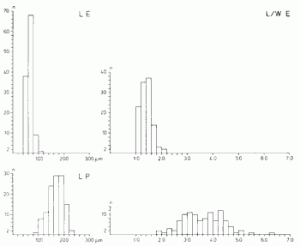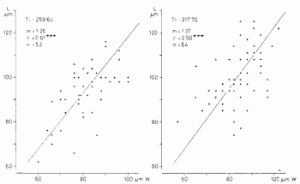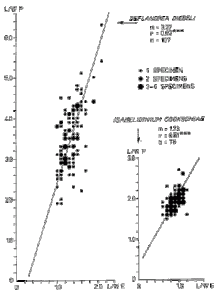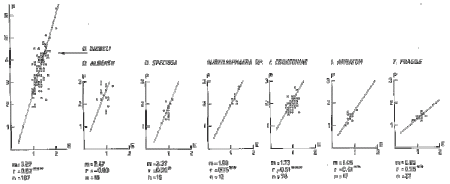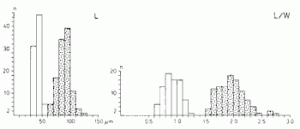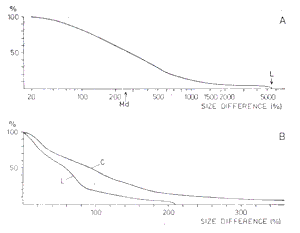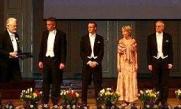The taxonomic classification of spherical microalgae is very complex, since:
- it is impossible to refer these forms to modern algal taxa because of the lack of relevant characters for classification
- vegetative cells and resting stages (cysts) cannot be discriminated with respect to only fossilized parts;
- cell shape and ornamentation may vary between different stages of the algal life cycle and can be modificatively affected by environmental factors, such as nutrition and temperature
- excystment features (pylomes, ruptures) are not constant in the algal life cycle, and excystment apertures (pylomes) cannot be discriminated always with certainty from apertures in vegetative stages, e.g. flagellar pores.
Leiosphaeridia (Eisenack 1958) comprises acid resistant, spherical to ovoidal microfossils without processes, without divisions into fields, and without traverse and longitudinal furrows or girdles. The cell wall is thin and without tubes, the surface is smooth or with slight ornamentation. An aperture (pylome) may be present, and has been considered as an excystment mechanism. Other methods of dehiscence are also recorded, e.g. by a split.
The original diagnosis by Eisenack in 1958 was slightly emended by Downie and Sarjeant in 1963 to include slight ornamentation and to exclude reference to colour. However, the view on color was taken earlier, and published by Eisenack in 1962.
Leiosphaeridia was established to accommodate leiospheres not attributable to Tasmanites (Newton 1875) because the nomenclatural type of Leiosphaera—a genus introduced by Eisenack in 1938—proved to be conspecific with a species of Tasmanites.
Synonymy
- Kildinella, Lophosphaeridium, and Protoleiosphaeridium do not display any differences from the diagnosis of Leiosphaeridia. Also Leiopsophosphaera and Uniporata seem to be congeneric with Leiosphaeridia.
- Leiosphaeridium is an illegitimate name. Macroptycha and Scaphita are not validly published.
- Campenia and Lancettopsis may be congeneric with Leiosphaeridia, but are not examined.
Kildinella (Shepeleva & Timofeev ex Timofeev) comprises according to the protologue smooth or shagreen spherical microfossils, ranging from 15 to 70 µm in diameter, with clearly delimited folds. They differed from Leiosphaeridia specimens only in being smaller and having denser membranes.
The folds evidently were generated by compression and the restricted size range is of no taxonomic value. When I examined the original material of Kildinella, I could not find any distinct features different from the diagnosis of Leiosphaeridia.
Kildinella was established by Shepeleva & Timofeev in 1963, but no species was described and no nomenclatural type was indicated. Thus the name was not validly published until Timofeev in 1966 described Kildinella hyperboreica and designated it as the type species.
Only a few species of Kildinella have been described. My friend, the Late Professor Boris V. Timofeev showed to me in Leningrad 1979 that they are essential parts of biostratigraphically useful microalgal assemblages identified in the pre-Cambrian of the Soviet Union.
Lophosphaeridium (Timofeev ex Downie) differs from Leiosphaeridia only in having a tuberculose ornamental sculpture. The difference is diffuse and a more or less developed ornamentation is the only feature for the generic classification. When I examined the original material of Lophosphaeridium, I could not find any distinct features different from the diagnosis of Leiosphaeridia. However, I regarded more extensive analyses required for establishing the taxonomic relations.
Lophosphaeridium was introduced by Timofeev in 1959 but as no type species was selected it was not valid until Downie designated the nomenclatural type in 1963.
Protoleiosphaeridium comprises small leiospheres (less than 50 µm in diameter) with smooth or shagreen surface, and ranges completely within the diagnosis of Leiosphaeridia. This genus was established by Timofeev in 1959, and became valid by designation of a lectotype in 1960. The circumscription of the genus was slightly expanded by Staplin in 1961 as to include all types of minor overall ornamentation. Leiosphaeridia and Protoleiosphaeridium were treated as congeneric by Downie & Sarjeant in 1963.
Leiopsophosphaera (Naumova) comprises large cells with smooth or shagreen, pitted surface. Dr Pykhova told me in 1978 that Leiopsophosphaera differs from Leiosphaeridia and Uniporata only in the sculptural ornamentation. This Proterozoic and Palaeozoic genus seems to range within the diagnosis of Leiosphaeridia.
A more detailed investigation of the taxonomy should indude a close examination of the original material if it is preserved. Studying that material was not possible for me, nor was I able to find Naumova’s paper from 1960 with the original diagnosis. Leiopsophosphaera and Leiosphaeridia were treated as congeneric by Yin & Li in 1978.
Uniporata (Naumova in Pykhova) comprises cells with ornamented surface and a large pylome. Dr Pykhova told me in 1978 that Uniporata differs from Leiosphaeridia only in having a large pylome. The type species indicated in the protologue of Uniporata is a nomen nudum and thus the name is not validly published.
The Proterozoic and Palaeozoic genus Uniporata was established by Naumova in Pykhova 1969. It seems to range within the diagnosis of Leiosphaeridia. A more detailed investigation of the taxonomy should indude a close examination of the original material if it is preserved. Studying that material was not possible for me.
Leiosphaeridium was proposed by Timofeev in 1959 as an amendment of Eisenack’s Leiosphaera. The original spelling of a name is to be retained and Leiosphaeridium is not to be considered an orthographic variant of Leiosphaera. As the name is nomenclaturally superfluous, it is illegitimate.
Staplin emended Timofeev’s diagnosis of Leiosphaeridium and regarded the name “as a new generic taxon” with L. eisenackii (Timofeev) as a new type species. Based on a different type the name is a later homonym and thus illegitimate.
The transference to Leiosphaeridia of Leiosphaeridium eisenackii made by Downie & Sarjeant in 1963 is not valid since it is done without clear references to the basionym.
Macroptycha and Scaphita are names used by Timofeev in 1973 for boat-shaped forms with large longitudinal folds or without folds, respectively. However, both names were not validly published. The folds were interpreted as prolonged chambers, but evidently represent compressional features. Before 1973 forms identical with Macroptycha and Scaphita were referred to Leiosphaeridia by Timofeev and others.
Campenia, described by Mädler in 1963, differs from Leiosphaeridia in possessing an elliptical slit that is supposed to be homologous with the pylome. The diagnosis of Leiosphaeridia, however, does not exclude opening by a slit. Lancettopsis—also described by Mädler in 1963—comprises folded and rolled up vesicles similar to Scaphita. Analyses of the original material is required for establishing the taxonomic relations.
Complex classification
To illustrate the complex leiosphere classification two species may be mentioned.
Protoleiosphaeridium papillatum was described by Staplin in 1961. Two years later—in 1963—it was transferred (but not validly) to Leiosphaeridia by Downie & Sarjeant, and further five years later—in 1968—to Lophosphaeridium by Martin.
Protoleiosphaeridium granulosum was also introduced by Staplin in 1961. It was in 1963 transferred by Downie & Sarjeant to Leiosphaeridia, and in the same year by the same Downie (without Sarjeant as coauthor) to Lophosphaeridium. Both these transferences are, however, contrary to the nomenclatural rules, and the valid publication of the name Leiosphaeridia granulosa was made by Pocock in 1972—but for a different taxon!
New species
I have described two new species of acid resistant spherical microalgae, referable to genus Leiosphaeridia, from the Upper Cretaceous of the province Scania (Skåne), southern Sweden.
Leiosphaeridia nelliae Lindgren 1982c is described from a Cenomanian clay deposit penetrated by a boring at Åhus in the Kristianstad area. This species is diagnosed by its small size and the lack of apertures or any obvious dehiscence mechanism. It resembles some Palaeozoic species, but all Mesozoic species with similar appearance are much larger.
Leiosphaeridia scanica Lindgren 1984 is described from the Campanian and Maastrichtian penetrated by a boring at Trelleborg. This species differs from other species of Leiosphaeridia in having a smooth vesicle and a constantly present pylome.
Leiosphaeridia asperata (Naumova) Lindgren is a new combination I established in my 1982b paper with Trachytriletus asperatus Naumova as basionym.
References
- Eisenack, A., 1958.
- Tasmanites Newton 1875 und Leiosphaeridia n.g. als Gattungen der Hystrichosphaeridea. Palaeontographica Abt. A, 110: 1—19. Stuttgart.
- Eisenack, A., 1962.
- Einigen Bemerkungen zu neueren Arbeiten uber Hystrichosphären. Neues Jb. Geol. Paläont. Mh., 102: 92—101. Stuttgart.
- Downie,C. & Sarjeant, W.A.S., 1963.
- On the interpretatio and status of some hystrichospher genera. Palaeontology, 6: 83—96. London.
- Lindgren, S., 1981.
- Remarks on the taxonomy, botanical affinities, and distribution of leiospheres. (Summary in Russian) Stockholm Contrib. Geol., 38(1): 1—20. Stockholm. ISBN 91-22-00500-5. ISSN 0585-3532. — Buy at the lowest prices among books in Sweden.
- Lindgren, S., 1982a.
- Taxonomic review of Leiosphaeridia from the Mesozoic and Tertiary. Stockholm Contrib. Geol., 38 (2): 21—33. Stockholm. ISBN 91-22-00502-1. ISSN 0585-3532. — Buy at the lowest prices among books in Sweden.
- Lindgren, S., 1982b.
- Algal coenobia and leiospheres from the Upper Riphean of the Turukhansk region, eastern Siberia. Stockholm Contrib. Geol., 38 (3): 35—45. Stockholm. ISBN 91-22-00504-8. ISSN 0585-3532. — Buy at the lowest prices among books in Sweden.
- Lindgren, S., 1982c.
- A new taxon of Leiosphaeridia (algae) from Upper Cretaceous clays, southern Sweden. Stockholm Contrib. Geol., 37 (11): 139—143. Stockholm. ISBN 91-22-00487-4. ISSN 0585-3532.
- Lindgren, S., 1984.
- A new taxon of Leiosphaeridia (algae) from Upper Cretaceous clays, southern Sweden. Stockholm Contrib. Geol., 39 (5): 139—144. Stockholm. ISBN 91-22-00517-x. ISSN 0585-3532. — Buy at the lowest prices among books in Sweden.



 Posted by Svenolov Lindgren
Posted by Svenolov Lindgren 
